
Dynamic Energy Budgets in Biological Systems
By S.A.L.M. Kooijman, 1993
Cambridge University Press, Great Britain
ISBN 0-521-45223-6
Second edition appeared in 2000
Third edition appeared in 2010
Dynamic energy budget theory provides simple, mechanistic rules for
the uptake ans use of energy by those animals, fungi and micro-organisms
that require organic food substances in the diet. The implications of these
rules for physiological organisations and population dynamics are considered.
Predictions of the theory are tested against a wide variety of experimental
results. The theory explains body-size scaling relationships such as the
links between food intake and life span. In a concluding chapter, the theory
is applied to problems in ecotoxocology, to demonstrate the ability of
the model to extrapolate from laboratory to field.
Each topic is given a general introduction, followed by formulation
of the theory in elementary mathematical terms. Methodology aspects of
mathematical modelling are discussed in detail. Biologists and mathematicans
with a broad interest in fundamental and applied problems in biology will
find this book of great interest.
Summary of Contents
- 1) Energetics and Models
- The position of energetics in the biological
sciences; historical setting; the methology of modelling and the
philosophical status of biological theories
- 2) Individuals
- A systems theory view of individuals; the
significance of isomorphism and homeostasis in the light of
surface area vs volume relationships; critical evaluation of
measures for size, storage and energy; effects of
temperature
- 3) Energy acquisition and use
- A step by step discussion of mechanisms of energy
uptake and use by individuals with relevance to the DEB model
- 4) Analysis of the DEB modeL
- Summary of the model; Evaluation of its
consequences for the behaviour of individuals under a variety of
circumstances
- 5) Living together
- Evaluation of the consequences of the DEB model
for populations and communities; a discussion of additional
processes operating at the population level
- 6) Comparison of Species
- Body size scaling relationships; strategies of
parameter selection; evolutionary implications
- 7) Suborganismal Organization
- Relationships between the DEB model and models for
digestion, allometric growth of parts, protein synthesis and RNA
turnover
- 8) Ecotoxicity
- Uptake kinetics and the relationship with effects; the
relationship between effects on individuals and on populations
